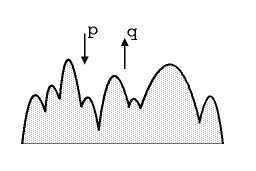STATIONARY STATE SKEWNESS IN KPZ TYPE GROWTH
|
Marcel den Nijs, 6th APCTP Bulletin, Korea (2000). Chen-Shan Chin and Marcel den Nijs, Phys. Rev. E, 59 , 2633-2641 (1999). Marcel den Nijs and John Neergaard, J.Phys. A 30, 1935 (1997). |
 BCSOS model growth rule |
surface growth:
|
At meso-scopic scales such processes are often modeled by Langevin equations. The bare stochastic deposition rate is modified by the local surface structure.For example, the surface grows faster in valley bottoms and slower at hill tops, i.e., we must include a term proportional to the surface curvature in the Langevin equation. In the absence of other terms, the Langevin equation is linear (a diffusion equation with noise). Such dynamic processes are known as Edwards-Wilkinson growth. Karder, Parisi, and Zhang (KPZ) pointed out that the slope dependence leads to a non-linear term (the square of the slope), and that such a term is generically present. The random noise keeps the surface active and rough. In the stationary state the root-mean square of the height difference between two points along the surface grows with distance as a powerlaw ra with a=1/2 in one dimension and a=2/5 in two dimensions. This absence of a characteristic length scale also shows in the approach to the stationary growing state. The characteristic time scale at which the surface reaches the stationary state diverges with surface width L as, t~Lz, with dynamic critical exponent z=2-a. These scaling properties of the surface are robust and universal and do not vary with the details of microscopic growth rule. They only change in the presence of additional conservation laws. |
stationary state skewness:
|
 |
In 2D, skewness is intrinsic to the scale invariance of the surface profile. It is non-tunable, and is typically negative. The third moment now scales with exponent 3a, and the amplitude ratio's of the various moments of the stationary state height distribution are universal. We established that these ratio's are indeed universal, and we determined some of their values .In addition, we clarified a lingering issue concerning the universality of the 2D roughness exponent, a=2/5. The spread in numerical values quoted in the literature, in particular between the KK and BCSOS models can be understood in terms of strong corrections to finite size scaling. |
home page of Marcel den Nijs